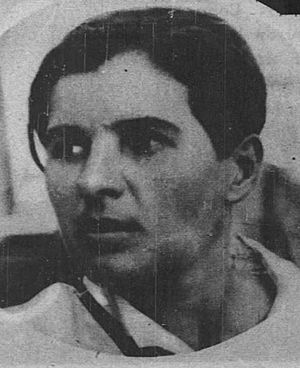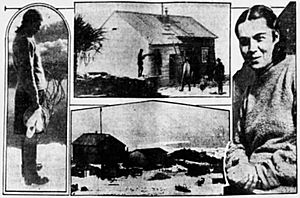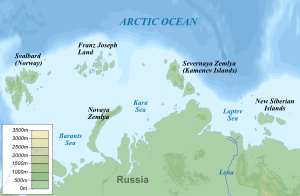Nina Demme facts for kids
Quick facts for kids
Nina Demme
|
|
|---|---|
| Нина Петровна Демме | |

Demme, 1932
|
|
| Born |
Nina Petrovna Demme-Ryabtseva
1902 Kostroma, Russian Empire
|
| Died | 1977 (aged 74–75) |
| Nationality | Russian |
| Other names | Nina Petrovna Demme, Nina Riabtzova-Demme |
| Occupation | polar explorer, biologist, ornithologist |
| Years active | 1921–1959 |
| Family | von Medem |
Nina Demme (Russian: Нина Петровна Демме, 1902–1977) was a brave Soviet polar explorer, a scientist who studied living things (a biologist), and a bird expert (an ornithologist). She was one of the first women to explore the cold Arctic region. Nina also became one of the first women to lead her own polar expedition.
Nina grew up in Kostroma, Russia. She went to one of Russia's first high schools for girls. Later, she studied to become a teacher. After special courses, she taught about working together (called collectivism). In 1921, she moved to Leningrad to study geography and biology. For eight years, she went on many trips to research the polar regions.
After graduating in 1929, Demme worked at the Arctic and Antarctic Research Institute. She joined a two-year trip to Franz Josef Land. She was the only woman in the group. Later, she led an expedition to Severnaya Zemlya. Her team mapped the western part of the islands. They also studied the plants and animals there.
When she returned to Leningrad in 1934, she studied how to raise northern animals for farms. She researched black foxes and how to breed eiders (a type of duck). In 1946, she earned her biology degree and became a professor. But Nina loved field research more than classrooms. She kept going on research trips until she retired in 1959. In her retirement, she enjoyed painting and tending her large garden. She passed away in 1977.
Contents
Nina's Early Life
Nina Demme was born in 1902 in Kostroma, in the Russian Empire. Her mother was Maria Ivanovna Ryabtsova. Her father was Ludwig Fedorovich Demme. Nina grew up in a big family. Her father was a German noble who moved to Russia. He ran a bicycle shop and later helped manage a brewery.
The family lived in Kostroma. They had a farm where they raised chickens and grew fruits and flowers. Nina's father loved birds. He was known for raising many rare kinds of pigeons. This early exposure to animals might have sparked Nina's interest in biology.
Nina's Education and Early Work
After finishing elementary school, Nina went to the private Grigorov Female Gymnasium. This was the first high school for girls in Russia. The school taught dance, music, languages, math, and science. Nina graduated in 1914. Then, she went to a teacher training school in Kostroma.
In 1917, Nina learned about the Bolsheviks. She quickly became a founding member of the Komsomol in Kostroma. This was a youth organization. By 1919, she was a leader in the Komsomol. In 1920, she went to Moscow for special courses. She studied about collectivism, which means people working together for the good of everyone. After her courses, she taught these ideas in the Ufa Governorate.
In 1921, Nina moved to Leningrad. She began studying at the Geographical Institute. She had many famous teachers. For eight years, she studied geography and biology. She went on research trips to places like the Caucasus and Crimea. She also worked on projects like road building and dog training. In 1926, she led a trip to the Kara Sea. In 1927, she did research in the Urals. She also worked in Central Asia to prepare for land reforms. While in school, she married a fellow student and polar explorer.
Nina's Career as an Explorer
Arctic Exploration and Leadership
In 1929, Nina graduated and started working at the Arctic and Antarctic Research Institute. This institute was founded in 1930. Because of her experience, Nina was chosen for an expedition on an icebreaker ship called the George Sedov. The plan was to spend the winter on Franz Josef Land. Nina was the only woman among the scientists. She studied the geography and biology of the area. The crew stayed on the island for two years. Nina helped measure water and studied wildlife and plants.
In 1932, Nina Demme made history. She led a team of three men to spend the winter in the Kamenev Islands. Newspapers reported that she was the first woman to lead a polar expedition. Her team included a hunter, a weather expert, and a radio operator. They sailed on the Roussanov and arrived on August 14. They lived in a cabin with a bedroom, a library, and a dining table.
Nina was made the "governor" of the islands. This meant she was in charge of trade and other important matters. Her team's goal was to see if the islands' plants and animals could be used for business. They collected rock and plant samples. They also studied different animals. They mapped the western part of Severnaya Zemlya. The ice was too thick for ships to reach them, so they stayed for a second winter.
During their time, they had some adventures. Once, while hunting, the men almost mistook Nina for a polar bear! She had to sing loudly to let them know it was her. In September 1934, a pilot flew from Siberia to rescue Nina and her crew.
Academic Career and Eider Research
After returning to Leningrad, Nina began advanced studies at the Arctic and Antarctic Research Institute. She also taught biology and zoology there. She was very interested in how to raise northern animals for commercial farming. For several seasons, she studied black foxes. When the Institute couldn't fund her trips, Nina rented small fishing boats. She used them to reach remote Arctic huts for her research.
Around 1940, she started a special project. She used methods from Iceland to create experimental eider farms. These were on Novaya Zemlya and Vaygach Island. Eiders are ducks known for their soft down feathers. By building nests and protecting the birds from predators, local people, guided by Nina, collected a lot of eiderdown. Over five years, they gathered about 5,354 kilograms (11,799 pounds) of down.
In 1946, Nina completed her big research paper. It was called Nesting Colonies of the Common Eider on Novaya Zemlya and the Organization of the Eiderdown Economy. This work earned her a Candidate's Degree in biology.
In 1949, Nina became an associate professor. But she preferred being out in the field. She kept hiring small boats to study wildlife in the Arctic. In 1949, she worked in the Kandalaksha Nature Reserve on the White Sea. She continued her work on eiders there. She tried to create domesticated hatcheries for the chicks. She brought some chicks back to Leningrad, but they did not survive.
Nina made her last trip to the Arctic in 1952. She worked in northern Siberia, focusing on raising animals. Her experimental eiderdown farms continued to operate until 1954. In 1959, she retired and wrote her life story. She bought a summer house on the Black Sea coast. There, she built a home and a large garden with many flowers and trees. Nina was also a talented musician and artist.
Nina's Later Life and Legacy
Nina Demme passed away on March 16, 1977, in Leningrad. She was cremated, and her remains were buried in Kostroma. Today, Nina Demme is remembered as one of the first women to explore the polar regions. In recent years, there has been new interest in her important work on producing eiderdown.
Images for kids







